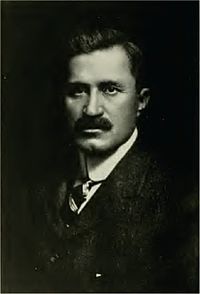Hamburg Place
| John Edward Madden | |
|---|---|
 |
|
| Born |
December 28, 1856 Bethlehem, Pennsylvania |
| Died | November 3, 1929 New York City, New York |
| Occupation | Athlete Businessman Racehorse owner/breeder/trainer |
| Signature | |
John Edward Madden (1856–1929) was a prominent American Thoroughbred and Standardbred owner, breeder and trainer in the late nineteenth and early twentieth century. He owned Hamburg Place Stud in Lexington, Kentucky and bred five Kentucky Derby and Belmont Stakes winners.
He was inducted into the National Racing Hall of Fame posthumously in 1983. He was also inducted into the Harness Racing Hall of Fame for his contributions to the sport as a trainer, breeder and owner. He is the only person to be inducted into both the Harness and Thoroughbred Halls of Fame. He was also a businessman, who invested in corn refining.
John E. Madden was born on December 28, 1856 in Bethlehem, Pennsylvania to Patrick and Catherine (McKee) Madden, who were Irish immigrants from Roscommon. Madden's father died in 1860, which resulted in hardship for the family. Young Madden often had to rely on his wits and athleticism to survive. He worked for four years in the local steel mills as a teenager and often fought in prizefighting as a young man to earn money. Boasting an athletic build, at nearly six feet tall and weighing 180 pounds, Madden excelled in baseball, running and broadjumping. By the age of 16, he had developed an interest in trotters.
Adept at recognizing subtle differences in gait and performance in Standardbreds, both pacers and trotters, from his time driving and training horses, Madden soon amassed a small fortune from buying promising but unseasoned animals, at low prices, developing them into winners and selling them at a profit. By the time he was thirty, he had made $150,000 through his dealings. He said, "Better to sell and repent than keep and resent." Madden notably owned Class Leader, who set a track record at the Cleveland Grand Circuit Race in 1887, Robert McGregor and Siliko. By 1890, Madden realized that Thoroughbred racing was attracting higher purse values than harness racing, and he gradually shifted his interests. Into the 1900s, he still owned and trained a few Standardbreds.
...
Wikipedia
